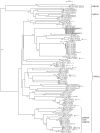Clinical and molecular epidemiology of human rhinovirus C in children and adults in Hong Kong reveals a possible distinct human rhinovirus C subgroup
- PMID: 19708791
- PMCID: PMC7199882
- DOI: 10.1086/605697
Clinical and molecular epidemiology of human rhinovirus C in children and adults in Hong Kong reveals a possible distinct human rhinovirus C subgroup
Abstract
Background: A novel human rhinovirus (HRV) species, HRV-C, was recently discovered, but its clinical features and epidemiology, compared with HRV-A and HRV-B, remains poorly understood, especially in adults.
Methods: One thousand two hundred nasopharyngeal aspirate samples obtained from hospitalized children and adults during a 1-year period were subject to reverse-transcriptase polymerase chain reaction to detect HRV. The clinical and molecular epidemiology of the 3 HRV species was analyzed.
Results: HRVs were detected in 178 (29.7%) of 600 nasopharyngeal aspirate samples from children and 42 (7%) of 600 nasopharyngeal aspirate samples from adults. HRV-A was most prevalent (n=11), followed by HRV-C (n=91) and HRV-B (n=18). Although upper respiratory tract infection was the most common presentation in children, 8 (62%) of the 13 adults with HRV-C infection had pneumonia, compared with 6 (27%) of the 22 adults with HRV-A infection (P<.05). Wheezing episodes were also more common among individuals with HRV-C (37%) and HRV-A (20%) infection than among those with HRV-B (0%) infection (P<.05). Clinical and molecular data analysis revealed HRV-C as a frequent cause of community and institutionalized outbreaks. A diverse set of HRV-C genotypes was circulating throughout the year, among which a potential distinct subgroup of strains was observed.
Conclusion: HRV-C is associated with pneumonia in adults and outbreaks of respiratory infections requiring hospitalization. A potential novel HRV-C subgroup was identified.
Figures


Similar articles
-
Detection of human rhinovirus C in fecal samples of children with gastroenteritis.J Clin Virol. 2012 Apr;53(4):290-6. doi: 10.1016/j.jcv.2012.01.008. Epub 2012 Feb 7. J Clin Virol. 2012. PMID: 22317907 Free PMC article.
-
Epidemiologic, clinical, and virologic characteristics of human rhinovirus infection among otherwise healthy children and adults: rhinovirus among adults and children.J Clin Virol. 2015 Mar;64:74-82. doi: 10.1016/j.jcv.2015.01.007. Epub 2015 Jan 13. J Clin Virol. 2015. PMID: 25728083 Free PMC article.
-
Prevalence and clinical characterization of a newly identified human rhinovirus C species in children with acute respiratory tract infections.J Clin Microbiol. 2009 Sep;47(9):2895-900. doi: 10.1128/JCM.00745-09. Epub 2009 Jul 22. J Clin Microbiol. 2009. PMID: 19625482 Free PMC article.
-
Rhinovirus infections in the upper airway.Proc Am Thorac Soc. 2011 Mar;8(1):79-89. doi: 10.1513/pats.201006-039RN. Proc Am Thorac Soc. 2011. PMID: 21364225 Review.
-
Clinical and molecular features of human rhinovirus C.Microbes Infect. 2012 Jun;14(6):485-94. doi: 10.1016/j.micinf.2011.12.011. Epub 2012 Jan 12. Microbes Infect. 2012. PMID: 22285901 Free PMC article. Review.
Cited by
-
A mechanistic role for type III IFN-λ1 in asthma exacerbations mediated by human rhinoviruses.Am J Respir Crit Care Med. 2012 Mar 1;185(5):508-16. doi: 10.1164/rccm.201108-1462OC. Epub 2011 Dec 1. Am J Respir Crit Care Med. 2012. PMID: 22135341 Free PMC article.
-
Molecular epidemiology and clinical impact of rhinovirus infections in adults during three epidemic seasons in 11 European countries (2007-2010).Thorax. 2020 Oct;75(10):882-890. doi: 10.1136/thoraxjnl-2019-214317. Epub 2020 Aug 20. Thorax. 2020. PMID: 32820081 Free PMC article.
-
Genetics, recombination and clinical features of human rhinovirus species C (HRV-C) infections; interactions of HRV-C with other respiratory viruses.PLoS One. 2009 Dec 30;4(12):e8518. doi: 10.1371/journal.pone.0008518. PLoS One. 2009. PMID: 20041158 Free PMC article.
-
Human rhinovirus C infections mirror those of human rhinovirus A in children with community-acquired pneumonia.J Clin Virol. 2010 Oct;49(2):94-9. doi: 10.1016/j.jcv.2010.07.013. Epub 2010 Aug 21. J Clin Virol. 2010. PMID: 20728404 Free PMC article.
-
Identification of a novel feline picornavirus from the domestic cat.J Virol. 2012 Jan;86(1):395-405. doi: 10.1128/JVI.06253-11. Epub 2011 Oct 26. J Virol. 2012. PMID: 22031936 Free PMC article.
References
-
- Macfarlane JT, Colville A, Guion A, Macfarlane RM, Rose DH. Prospective study of aetiology and outcome of adult lower-respiratory-tract infections in the community. Lancet. 341:511–4. - PubMed
-
- Ruiz M, Ewig S, Marcos MA, et al. Etiology of community-acquired pneumonia: impact of age, comorbidity, and severity. Am J Respir Crit Care Med. 160:397–405. - PubMed

